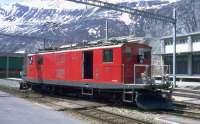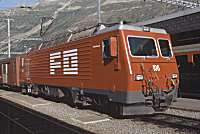
FO

The Furka-Oberalp Railway is the only railway connection which runs through the Swiss Alps in the east-west direction. It leads from Disentis (Grison) over Andermatt (Uri) to Brig in the Wallis. The line touches the Rhine Valley, Oberalppass, Urseren Valley, and the Goms (upper Rhone Valley). The line meets the Gotthard massif and the sources of Rhine, Rhone, Reuss and Ticino. Over its length of 100 km more than 1600 elevator meters height are overcome several times. A 4km long branch line leads down to Goschenen and connects Andermatt with the entrance of the Gotthard tunnel. In Disentis the FO is connected to the network of the Rhaetian Railway, in Brig to that of the Swiss Federal Railways (SBB), the Brig-Visp-Zermatt Railway (BVZ) and the Bern-Lotschberg- Simplon Railway.
 Because of the extremely difficult high mountain landscape the line was
created as metre gauge adhesion and rack railway. The FO chose the Abt
rack system, which is also used by the neighbouring Visp-Zermatt
Railway. The electrification was made with alternating current, 11 kV 16
2/3 cycles per second, like RhB and BVZ. The three railways form a
large, technically uniform network which permits an almost free
interchange of cars.
Because of the extremely difficult high mountain landscape the line was
created as metre gauge adhesion and rack railway. The FO chose the Abt
rack system, which is also used by the neighbouring Visp-Zermatt
Railway. The electrification was made with alternating current, 11 kV 16
2/3 cycles per second, like RhB and BVZ. The three railways form a
large, technically uniform network which permits an almost free
interchange of cars.
Touristic traffic forms the main part of traffic, especially the transit with the famous Glacier Express. With the opening of the Furka-Basistunnel in 1982 a very successful car shuttle service was also introduced. The regional traffic is made be shuttle trains, led by railcars.
 From the beginning of the electrification the HGe 4/4 I locomotives
have been the backbone of transport. Today the old locos can still be
found in subordinated services. With the increasing of the transit
traffic the slow (55 km/h) and old machines were not sufficient and
became outdated. Their descendants have been delivered in 1986 and 1990.
This series of eight locomotives is equipped with adhesion and rack
drivers, too. These HGe 4/4 II
called type is used also on the BVZ and the
SBB Bruenig line.
From the beginning of the electrification the HGe 4/4 I locomotives
have been the backbone of transport. Today the old locos can still be
found in subordinated services. With the increasing of the transit
traffic the slow (55 km/h) and old machines were not sufficient and
became outdated. Their descendants have been delivered in 1986 and 1990.
This series of eight locomotives is equipped with adhesion and rack
drivers, too. These HGe 4/4 II
called type is used also on the BVZ and the
SBB Bruenig line.
On the original route Disentis-Brig the largest gradient is 11%. The branch down to Goschenen falls even around 17.9 %. This causes numerous operational restrictions. The signalling was adapted to the most modern request within the last years. Special public favourites are the 1986-1993 produced wide glassed panoramic coaches, which offer a completely new travel feeling.
In November 1998 the FO opened their new depot with integrated main workshop after a planning of 20 years. It is located in the Glisergrund nearby Brig. This depot replaces the old workshops at Brig station, which couldn't be used for a modern railway enterprise due to the cramped space conditions.
Copyright © 1996
Author: Stefan Dringenberg, last change on 2001-08-21